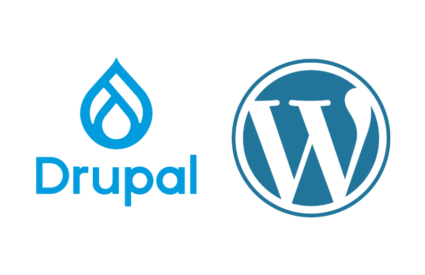A new year means a new look at what’s on the horizon. Kanopi is always looking ahead to what is happening in the development space, so we asked our team to give their thoughts on what’s ahead for next year.
We’ve split this into three sections:
- The top WordPress trends for 2023
- The top Drupal trends for 2023
- The top website development trends (regardless of CMS) for 2023
Let’s start with WordPress …
Top WordPress trends for 2023
New WordPress, new theme, same direction
With the release of WordPress 6.1, Twenty Twenty-Three has already arrived; the new default theme is called (numerically incremented, as usual) Twenty Twenty-Three (TT3). What hasn’t changed is the focus on Full Site Editing (FSE). In fact, TT3 continues with the trend of moving towards FSE. Block patterns are prevalent and variations are implemented theme-wide to allow for a huge variety of customizations (10 theme style variations!) without having to touch any code whatsoever.
What else is new in WordPress 6.1
WordPress 6.1 released on November 2nd with many improvements with much of the focus placed on accessibility and performance. Both of these areas were Identified by developers and the community (after heavy criticism) as needing more love as the Gutenberg block editor received the lion’s share of updates in recent releases.
Happily, many needed improvements and fixes were implemented in this release. Below are links to comprehensive lists of the updates, including:
- WordPress 6.1 Accessibility Improvements
- Performance Field Guide for WordPress 6.1
- WordPress 6.1 Block Editor Improvements
Need more of a beginner’s guide? This blog post is a great resource.
Other Trends / Predictions
- Agencies are figuring out how to stay on top of the changes with Gutenberg, building Block themes, and Full site editing.
- Block Patterns will continue to be used and will become ubiquitous across any block-based theme.
Top Drupal trends for 2023
Drupal continues its rapid development pace, adding more secure and performant code releasing Drupal 10 on the backbone of Symfony 6 and PHP 8.1.
Upgrading from Drupal 9 to Drupal 10 is easy using the drupal-rector tool, which looks for deprecated code. There are also a large number of contributed modules that already have been ported. So if you’re on D9, moving to D10 should be easy.
Drupal 10 features include:
- The new, modern Claro administration theme, which provides a better administration experience.
- Olivero default theme, which is the new default front-end theme for Drupal with a modernized look and feel
- CKEditor 5 which provides a much better authoring experience and more modern editing.
- Modern JavaScript components to replace some uses of jQuery for better performance.
- Theme Starterkit tools for bespoke theme creation.
But as the Drupal crew is ever working hard to keep evolving, the work has already begun to be included in Drupal 11. The following core initiatives are being worked on in the contrib community, and will be merged into core when they are ready:
- Project Browser: this will allow ambitious site builders to discover and install modules and theme from their admin screens.
- Drupal Recipes: allows site builders to install and configure groups of modules to achieve features such as an event section, or a blog.
- Automated Updates in Core.
- A more streamlined Core: the Great Module Migration continues moving lesser used modules from core to the contrib community for a smaller Drupal core.
General website trends
Performance and Speed
As we wrote in a blog post about Core Web Vitals earlier this year, research shows the chance of a bounce increases by 32% when a page load time takes one to three seconds, and by 90% when the page load time takes up to five seconds. Speed matters! Make sure to take a look at your Core Web Vitals.
Accessibility
This is a drum that Kanopi beats frequently, but that’s because it’s really that critical. 26% of US adults identify as being permanently disabled in some way. If you count those with temporary disabilities like a broken wrist, or situational disabilities like being on a noisy subway, the number climbs considerably. That’s a huge percentage of people that feel alienated when a site isn’t accessible to them. There are many ways to make a site accessible, including adding captions and alt text to images and videos, ensuring proper contrast, and entering content with a correct heading structure. Make 2023 the year you decide to make your site as accessible as possible.
Thumb-Friendly Mobile Navigation
In 2022, 60% of all website traffic came via mobile devices, so a mobile-first approach is imperative. This also means that all critical elements on a website must be within easy reach of a user’s thumbs, including the navigation. Think about what’s really necessary on each page and what can get edited. Focus on a vertical orientation rather than a landscape one, and what functions need to be done on your site with a touchscreen.
Artificial Intelligence (AI and Machine Learning (ML)
2023 should be the year when companies will move forward with implementing both of these, if they haven’t already (and our Creative team sees this trend on the design and content side as well). On top of improving productivity and using data more efficiently, AI doesn’t have to prove its usefulness anymore. Plus, it’s become quite accessible to work with as most cloud platforms offer it as a plug-and-play service.
AI enables machines to learn from their experiences and make decisions without human intervention. This technology can be used to automate mundane tasks such as data entry or content generation, allowing developers to spend more time focusing on more complex problems. For example, there are plugins that can help you create better content for your website by using artificial intelligence.
ML is also being used in web development, enabling sites to better understand user intent and behavior so they can deliver personalized experiences tailored just for them. For example, think about how chatbots can deliver a personalized experience with your audiences.
Speaking of …
Personalization
It’s impossible to talk about future website trends without discussing personalization. The days of one-size-fits-all websites are quickly coming to an end as organizations look for ways to tailor their websites to individual users’ needs, wants, and interests. Consider that Gen Z has grown up with some degree of personalization and expects it, and apps such as Spotify and Netflix have already conditioned us to expect some personalized recommendations on what we hear and watch. (Personalization is also critical in content strategy and web design for 2023.)
While it initially felt uncomfortable or intrusive when platforms knew personal things about us, it’s now become a more mainstream experience that helps users get what they want or need faster.
A few examples:
- Geolocation: location services can help your audiences find events local to them.
- Product recommendation: a great example of online shopping is Patagonia. After filling out a questionnaire about sizing, the site predicts what size would be best on every single product page. The algorithm bases itself on the information a user shares but also the reviews it receives from similar users who made the purchase.
- Personalized newsletter: This is tangential to your website, but why ignore this critical marketing tool that leads readers to your website? It’s become a common practice to send a newsletter with content specific to your audience’s needs (and there’s lots of data to back up the power of personalized newsletters). Split up your newsletters by audience so you are speaking to their goals, then direct them to the content on your website so they do the conversions you want.
Voice Interfaces & Voice Search Optimization
Voice interfaces are becoming increasingly popular as more people turn to voice assistants such as Siri or Alexa for help with their online searches. To stay ahead of the curve, web developers need to start optimizing their sites for voice search by ensuring that all content is written in conversational language and utilizing structured data markup tools like Schema.org or Google’s Structured Data Markup Helper tool. This will ensure that your content is easily readable by search engines so that it shows up when people search via voice assistants.
Small bites can create big wins.
With these new developments come exciting opportunities for organizations looking to stay ahead of the competition. While some of these trends might not seem achievable or even necessary for your organization to implement at a large scale, even implementing some in smaller ways can garner big results. CMOs and marketing managers should keep an eye on these emerging trends so they can capitalize on them before their competitors do!
And as always, if you need any help with your websites in 2023, Kanopi is here to assist. Contact us anytime.








